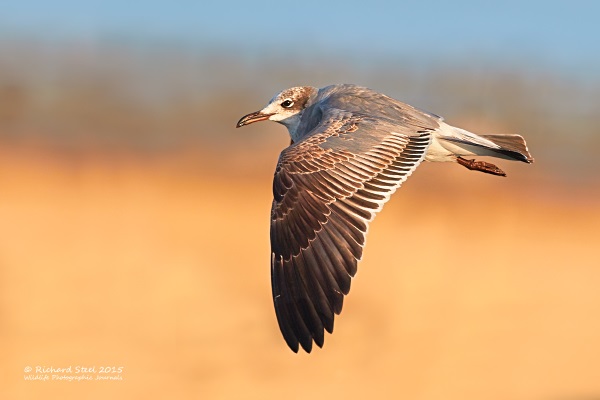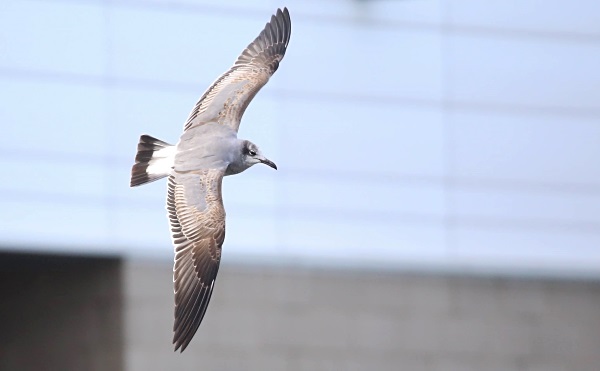Site menu:
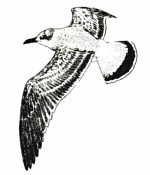
March 2015 Newsletter
Laughing Gull at New Brighton.
Highlights - March 2014 to Feb 2015.
Colour Ring Report.
February Bird News.
Forthcoming Events.
Latest Newsletter.
Laughing Gull at New Brighton
I was wardening at West Kirby on Tuesday Feb 3rd,
before we set off down the beach I scanned through a few roosting
Black-headed Gulls looking for colour-rings and when I rejoined my
fellow wardens I joked "four Laughing Gulls among that lot!", little
thinking I would actually be seeing one in just over an hour.
Remarkably, I was standing in the exact spot where the last Laughing
Gull had been seen in our area back in 2001, halfway between
Red Rocks
and West Kirby, when the text came through "Laughing Gull New Brighton on
pontoon NOW" - that was at 1045hrs. The response was "WOW" and I was on my
way.
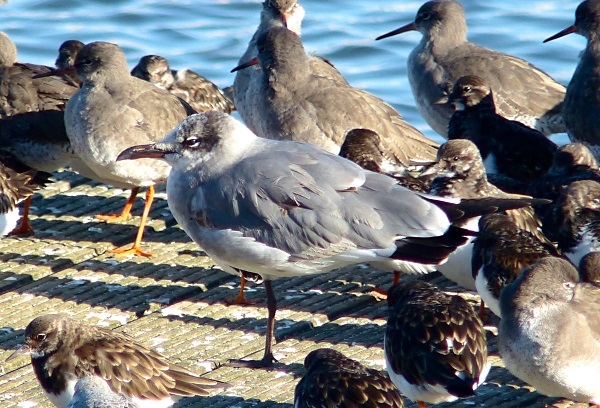
It was three birders from Manchester
who found it -
Mike Brown, Heath Green and Mike Rutter. As it was a lovely calm and
clear day they had decided to spend the day on Wirral, first stop was
the Snow Buntings at Wallasey followed by a 'Full English' at New
Brighton. Next up was the Marine Lake, one of the most reliable sites
in the north-west for Purple Sandpipers. What they hadn't expected was
a first winter Laughing Gull!! Luckily they had previous experience
with this species, and after double-checking in the Collins Bird Guide
they duly let the news out by phoning Bird Guides and the rest is
history, as the saying goes.
I got there just after high tide when it was on the Marine Lake pontoon and later it moved to the beach next to Fort Perch - and that was the pattern for the rest of the month although it was also seen on the promenade a few times feeding on chips, bread and even a large chicken bone! It certainly gave the visiting birders fantastic views as you can judge by the many photographs in this article.
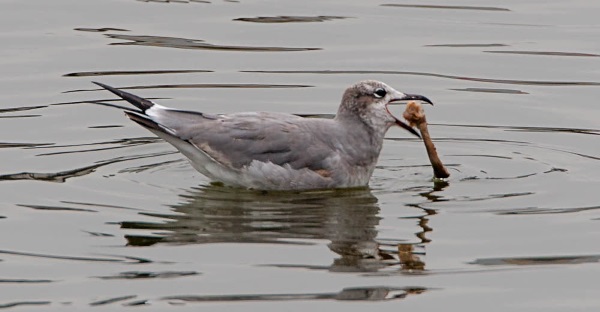
February 12th © Ron Thomas
Previous Records
This is the fourth record for the Dee estuary area, the previous ones were:
1. A first summer bird found off Hilbre on May 16th 1978.
2. A second winter at Point of Ayr on December 20th to 22nd 1991.
3. One on West Kirby Shore on October 2nd 2001.
There were also two 'possibles' with one past Hilbre in May 2006 and one off Greenfield in January 2007.
There have been three other accepted records in Cheshire and Wirral - New Ferry in 1977, Warrington and Woolston Eyes in 1985 and Houghton Green Pool in 1997.
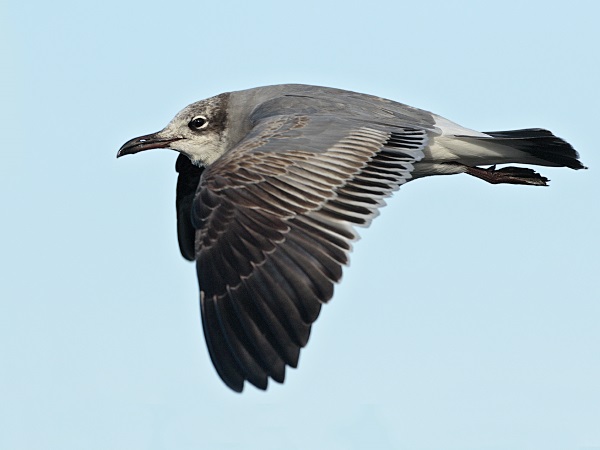
www.stevenround-birdphotography.com/
Laughing Gull Status
Laughing
Gulls breed mainly on the east and south coasts of the USA, and in the
Caribbean and Mexico. It used to be considered a pest and
persecuted with
numbers reaching such a low level that in 1913 it was given special
protection.
Since then numbers have rebounded and over the past 40 years
they have increased at an impressive 45% per decade so that the
population is now estimated at around 800,000.
In the UK the Laughing Gull is a vagrant and a national rarity so that records have to be assessed by BBRC (British Birds Rarity Committee) which is the official adjudicator of rare bird records in Britain. The first bird to be accepted was one at Dungeness on May 11th 1966, although since then two earlier records have retrospectively been accepted - one from 1923 and the other from 1957. Since 1975 records have increased significantly and we usually get between three and five birds a year in this country although they don't occur every year - for example there were none in 2008 or 2010, and there was only one in 2014. The increase in records since 1975 is probably linked to both the increase in the population as a whole and also the increase in the numbers of birders in this country and their greater awareness of this species.
An analysis of Laughing Gull records in the UK and across Europe undertaken by Dutch Birding indicates that the majority of newly arrived birds are first-years, they tend to arrive from the south-west then disperse so that subsequently they can turn up anywhere and at any time of year. At least some of the records of second-year birds and adults are due to these immature birds staying for a year or more. This arrival from the south-west was amply demonstrated during the remarkable events of November 2005 when Hurricane Wilma, the most intense hurricane ever recorded in the Atlantic, blew an unprecedented 53 Laughing Gulls to our country with the focus of the influx very much on the south-west peninsula and the Bristol Channel, including 12 in Cornwall and eight in Devon. Unfortunately none of these birds made it to the Dee estuary with the nearest one to the west in Porthmadog and to the north at Marton Mere, Lancashire.
But our patient wait for a twitchable Laughing Gull has certainly been rewarded and it is still here as I write this at the end of February having been seen every day since the 3rd.
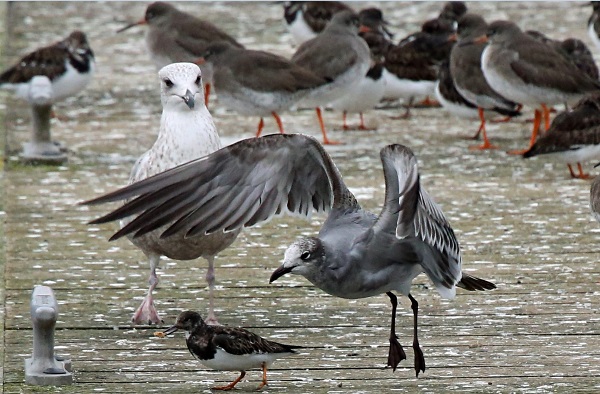
Sources of Information:
1. Mike Brown, Laughing Gull Finders Article, Lighthouse and Wirral Birding Blog: see entry for February 6th 2015 - http://lighthousebirding.blogspot.co.uk/.
2. Waterbird Population Estimates Fifth Edition, Wetlands International, 2012.
3. Allan Conlin and Steve Williams, Rare Birds in Cheshire & Wirral, C&W Birding Publications, 2004.4. Rare Birds in Great Britain, BBRC, Annual Reports 1966 to 2013, published in British Birds and online - http://www.bbrc.org.uk/resources.
5. BirdLife International (2015) Species factsheet: Laughing Gull Larus atricilla. Downloaded from http://www.birdlife.org on 23/02/2015.
6. Nearctic gulls in the Western Palearctic, Dutch Birding (12: 109-164), September 1990 - available online (in English) at http://www.dutchbirding.nl.
7. J.N. Dymond et.al, Rare Birds in Britain and Ireland, T & A D Poyser, 1989.
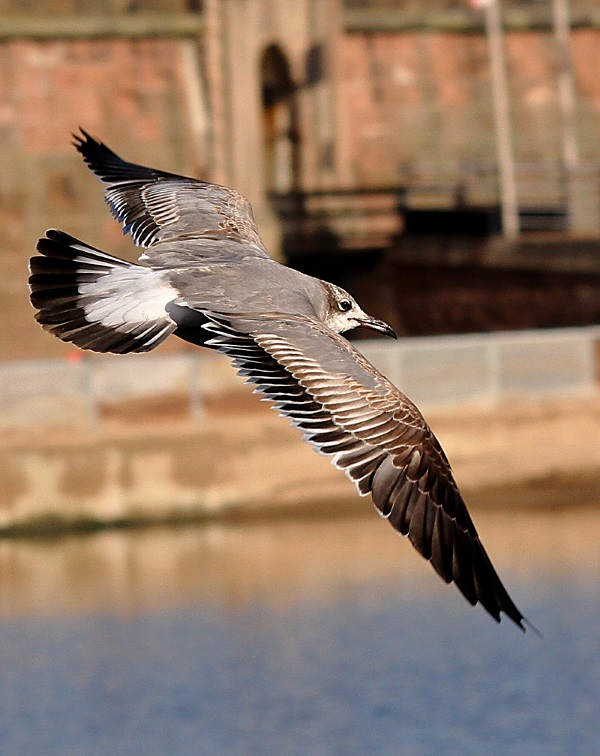
Richard Smith
Top of Page
Highlights - March 2014 to February 2015
On the 17th anniversary of the first newsletter on this website I again
publish the highlights of the past twelve months:
Rarities
A particularly good 12 months for rarities, even before the Laughing Gull turned up (see above). My list consists of 26 different records so here goes:
A Little Bunting and Night Heron in April, as well as Iceland and Glaucous Gulls.
A Citrine Wagtail, five Velvet Scoters and a Black Guillemot in May.
A Bee-eater in June, a pair of Spotted Crakes first reported in June successfully bred at Burton Mere Wetlands. Single Red-necked Phalaropes were seen in both June and September.
A Cattle Egret arrived at Burton Mere Wetlands in September and stayed until December. September also produced a Dotterel, both Barred and Marsh Warbler, Wryneck and White-rumped Sandpiper.
Sabine's Gull and Siberian Chiffchaff in October, single Grey Phalaropes were seen in October and January.
Another Barred Warbler was spotted in November and there were three Black-necked Grebes in December and January.Although not a county rarity Long-eared Owl is very much a vagrant around the Dee estuary and one was at Burton Mere Wetlands in February along with an American Wigeon. February also saw two Bean Geese with large numbers of Pink-footed Geese and a Slavonian Grebe in the River Dee channel by Connah's Quay. Then there was the Laughing Gull.....
In addition there were several reports of Great White Egrets, Black-throated Divers and Cetti's Warblers at various times through the year.
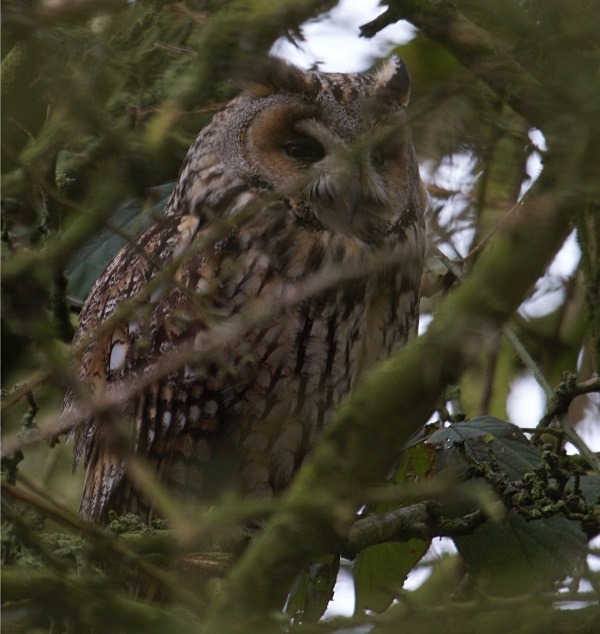
Sea Birds
The big story was the massive flock of 27,000 Common Scoters off Hilbre in March, we continued to have good numbers during the past winter with max of 7,000 in February. July saw 57 records of Mediterranean Gulls, gales in August resulted in a max count of 1,258 Manx Shearwaters past Hilbre and the highest count of Great Crested Grebes was at least 600 in September. 10 to 12 Long-tailed Ducks in December were more unusual. Large numbers of Cormorants roosted at night in the estuary in January with max 3,884 counted as they flew past Hilbre at dawn, we think that's the largest ever single site count of this species in the country. Single Glaucous Gulls were seen off Meols and Hilbre in April and at New Brighton and Hoylake in February.Waders and Wildfowl
Gilroy Nature Park, West Kirby, proved particularly attractive to migrating Black-tailed Godwits with 970 in April and a remarkable 4,900 in October. Late summer saw an exceptional number of migrant Dunlins with a max count of 12,700 in August. 262 Brent Geese equalled the highest ever count on the estuary and Pink-footed Geese continued to increase with 6,200 in January.The Rest
It was a particularly good spring migration for Common Redstarts with a total of 42 records in April. With strong southerly winds for many days through the autumn it was no great surprise to see late records for both Swifts (October 21st) and Swallows (November 28th). Every winter we seem to be getting more and more Twite at the Connah's Quay Reserve and this winter max was at least 200 in January. Two to four Snow Buntings spent the winter around the Leasowe and Wallasey shore area.The winter of 2013/14 was particularly good for big high tides which covered the marshes and this continued into March when at least seven Short-eared Owls were flushed by the tides with similar numbers during high tides in January and February 2015.
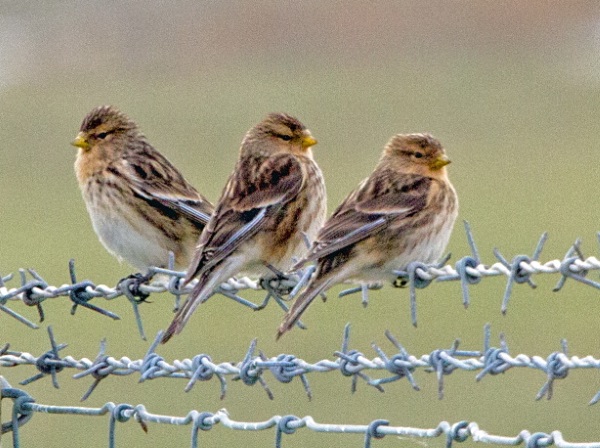
Colour Ring Report
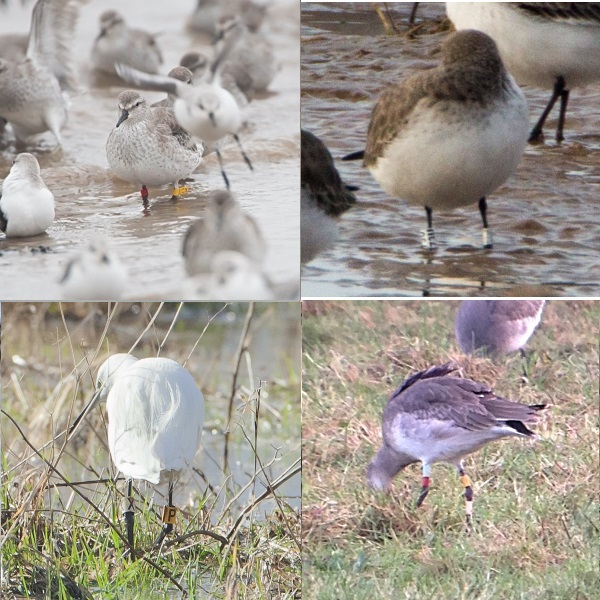
Over the past two months we've concentrated on gulls so it's time to
catch up on some other species, particularly waders.
Sanderling
G6GWRG - ringed at Hochstetter Forland, east Greenland, in July 2013.Recorded January 22nd 2015 at Hoylake.
Knot
L3LRGL
- ringed on the island of De Richel, Waddensea,
Netherlands, in August 2011.
Recorded December 27th 2014 at Thurstaston.
Previous records: recorded at Griend, Waddensea, Netherlands,
in August 2011.
Recorded January 23rd 2015 at Hoylake and February 17th 2015 at Thurstaston.
Previous records: recorded at Porsanger in May 2014 and twice at Hoylake in November 2014.
Matt Thomas has now seen this bird in Porsanger, Hoylake and Thurstaston all within a period of nine months!
For those who want to understand the colour ring codes used for Sanderlings and Knot take a look at: http://www.waderstudygroup.org/res/project/sand-colrings-en.php
Dunlin
73U
on white ring - ringed in September 2012 in Gdansk, Poland.
Recorded January 22nd 2015 at Hoylake.
CHL
on white ring - ringed in July 2013 in Gdansk, Poland.
Recorded January 22nd 2015 at Hoylake.
91V
on white ring - ringed in September 2012 in Gdansk, Poland.
Recorded January 22nd 2015 at Hoylake.
Black-tailed Godwit
LR-Y//W ringed at Holbeach, the Wash, as an adult female in September 1998.Recorded on Thurstaston shore in November and December 2014, and at Gilroy NR, West Kirby, and in a field at Newton in December 2014.
This bird is at least 18 years old.
Previous records: It's first sighting after ringing was on the Dee estuary in April 1999, the following August and September it was on the Humber Estuary. The next two years it was recorded at Cley in Norfolk, Breydon Water in Norfolk, Marshside RSPB on the Ribble Estuary and Iceland. December 2007 saw it at Thurstaston and it was at Leighton Moss in April 2008. From December 2008 to January 2014 it was recorded at Thurstaston many times during winter months with several visits to Frampton on the Wash in late summer and Leighton Moss in Lancashire in April.
Little Egret
X on white ring, P on yellow ring - ringed at Penryn near Bangor, North Wales, in June 2013 as a chick.Recorded on Neston Marsh on February 21st 2015.
Eight previous colour-ringed Little Egrets were also ringed at Penryn, these were all first year birds when recorded so XWPY is our first colour-ringed adult.
Richard Smith and Matt Thomas.
Ringed birds were also recorded by Steve Hinde, John Jakeman, Elliot Monteith and Allan Irving.
Top of Page
February Bird News
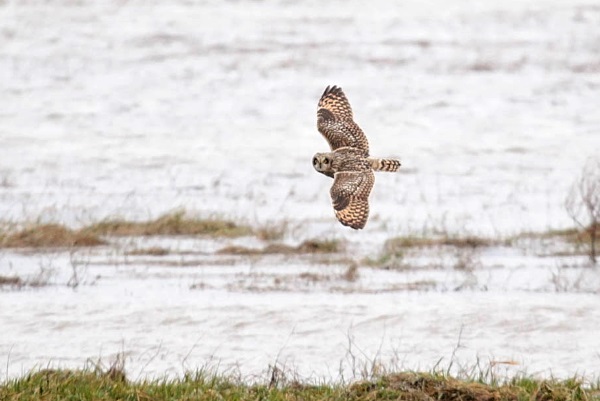
See austinmorley.blogspot.co.uk.
As we had hoped the high tides from the 19th to the 22nd covered the marsh and we got some great views. Five to six Short-eared Owls were seen each day although we only got a single Hen Harrier. On the 19th the Pink-footed Geese put on a spectacular display rising out of the marsh as the tide came in with 1,000 off Gayton and 3,000 at Parkgate. There were more Pink-footed Geese down at Burton and Shotwick so the total must have been approaching last month's record count of 6,200. The tide flushed several Water Rails and I saw six on the 20th, all of which seem to have avoided being eaten by the waiting Grey Herons! At least six Jack Snipes were counted and several hundred Skylarks flew over. As well as Parkgate and Gayton a good spot to see the tides was Neston Old Quay which is also a good place for Water Pipits and there were at least two in the area for most of the month.
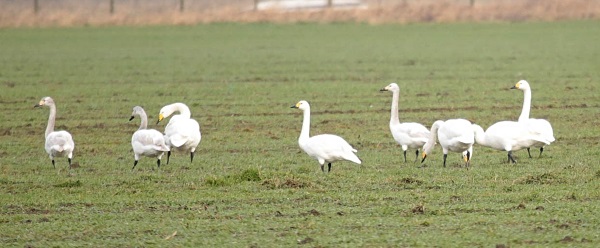
See austinmorley.blogspot.co.uk.
Over 40 each of Bewick's and Whooper Swans were on Shotwick Fields, along with several Mute Swans and a Black Swan. Calm weather early in the month meant for some great sea watching which produced 39 Scaup, 7,000 Common Scoter, 35 Goldeneye, 14 Eider, 20 Red-throated Divers and 209 Great Crested Grebes off north Wirral. A much rarer Slavonian Grebe was off Connah's Quay later in the month. The two Snow Buntings remained on Wallasey Shore and had increased to four by the 16th. Over 100 Twite were counted at Connah's Quay.
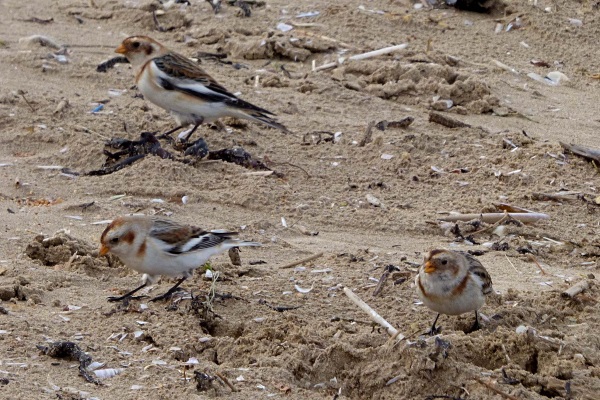
There was much excitement at New Brighton with the arrival of an immature Laughing Gull as described above, a Glaucous Gull joined it briefly on the pontoon on the 18th and it was presumably this bird on Hoylake Shore on the 21st. Other rarities included a Long-eared Owl at Burton Mere Wetlands and two Bean Geese where with the Pink-footed Geese on Shotwick Fields at the end of the month. Two Great White Egrets were recorded on several dates - perhaps they'll stay to breed!!
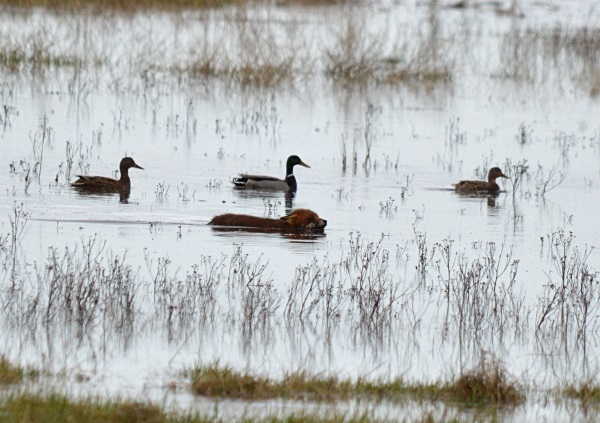
Richard Smith.
What to expect in March
| Species | 2014 | Location (2014) | 2013 | 2012 |
|---|---|---|---|---|
| White Wagtail | 8th March | Hilbre | 14th March | 8th March |
| Wheatear | 10th March | Leasowe Lighthouse | 17th March | 9th March |
| Willow Warbler | 12th March | Burton | 6th April | 20th March |
| Swallow | 19th March | Connah's Quay | 10th April | 17th March |
| Sand Martin | 20th March | West Kirby | 28th March | 28th March |
| House Martin | 29th March | Gronant | 12th April | 4th April |
| Whitethroat | 4th April | Leasowe Lighthouse | 15th April | 1st April |
| Cuckoo | 2nd May | Leasowe Lighthouse | 13th April | 14th April |
| Swift | 3rd May | Hilbre | 17th April | 26th April |
(
Out to sea we should get our first Gannets and Sandwich Terns of the year, and Common Scoters should be present in their thousands. Avocets should reach double figures at Burton Mere Wetlands, and if we are lucky we will see one or two Marsh Harriers and Ospreys.
Top of Page
Forthcoming Events
March Highest Spring Tides (Liverpool)
Also
see Tides
page.
20th March, 10.52hrs (GMT), 10.0m.
21st March, 11.37hrs (GMT), 10.2m.
22nd March, 12.21hrs (GMT), 10.2m.
23rd March, 13.05hrs (GMT), 10.0m.
Forthcoming Events
Organised by the Wirral
Ranger Service , Flintshire
Countryside Service and the
RSPB (Dee Estuary):
All these events and walks have bird interest, even those not
advertised specifically for birdwatching. No need to book for these
events unless specified - please check below.
Also see 2015 Events Diary.

Saturday 7th March 6.30am – 9am
Mad March Hares
An early start but worth it to have a chance of seeing Brown Hares on the fields of Thurstaston. These mammals are very active now and on a guided walk to the Dungeon Woodland we might be lucky enough to see them “boxing”.
Warm waterproofs, boots and binoculars recommended. Book early for this popular walk! (0151) 648 4371.
Friday 20th March to Monday 23rd March, RSPB Parkgate High Tide Birdwatch.
From 9am
Parkgate Marsh is one of the best wetland habitats in the northwest, and when it is flooded by an incoming Spring high tide, the wildlife which lives here is pushed closer, potentially delivering an awe-inspiring spectacle. Join us at Parkgate's Old Baths car park and the Donkey Stand near Nicholl's ice cream shop, where we'll be set up with marquees and telescopes hoping for the right weather conditions to really push the tide in.
You can expect great views of the large numbers of geese, ducks and wading birds which are here in their thousands for the winter. In addition, the small mammals living on the marsh can be flushed from cover, potentially attracting the kestrels, harriers and short-eared owls who spend the winter months here.
Car parking is limited on Parkgate promenade, but there is free public parking at the Old Baths car park (CH64 6RN) at the north end of The Parade, and the Wirral Country Park car park on Station Road (CH64 6QJ). There are public toilets at Mostyn Square in the middle of The Parade, and a number of pubs and cafes for refreshments.
High tide times:
Friday 20 March: 10.52 am (10.0m)
Saturday 21 March: 11.37 am (10.2m)
Sunday 22 March: 12.21 pm (10.2m)
Monday 23 March: 1.05 pm (10.0m)
Sunday 29th March, Skydancers on the Dee Estuary - Donkey Stand, Parkgate.
12noon - dusk
Price: Free
Most people have never seen a hen harrier, but once seen it is rarely forgotten. In support of the RSPB's Skydancer project, we are pleased to bring you a series of events to showcase these enigmatic birds of prey which use the marshes of the Dee Estuary as their home for the winter months.
The name "Skydancer" comes from the aerobatic displays that the male birds perform in their courtship ritual on the moors in the spring. Sadly, this has become an increasingly rare sight and they are close to becoming extinct as a breeding species in England.
This could be the last chance to see Skydancers on the Dee, so come along to Parkgate to find out more about the hen harrier story and what you can do to help save them before it's too late! Look for the RSPB marquee along the main promenade at Parkgate, where friendly staff and volunteers will be on hand with telescopes and binoculars to show you these beautiful, agile birds hunting over the marsh, and coming in to roost there at dusk. Plenty of family activities and other RSPB information will be available.
For more information on the RSPB's Skydancer project, visit
http://www.rspb.org.uk/skydancer/
Directions: The "Donkey Stand" opposite Nicholls Ice-cream shop on The Parade (B5135), Parkgate, Cheshire.
